Alliance will start Dota Pro Circuit 2023 more determined than ever.
The organization has high ambitions and has decided to not only rebuild its European team from scratch. It also bought a strong South American roster that participated at The International 2022 and finished 13th-16th. That roster used to represent Hokori.
About the former Hokori roster
Hokori had an amazing performance in the group stage of The International 11. The team lost just two matches out of the nine they played and was one point away from securing an upper bracket spot for the playoffs of the tournament.
Unfortunately, their run ended in the first round of the lower bracket after they got defeated by another South American team, beastcoast.
Most of the former Hokori players are not known at all. The only one who has gained popularity over the years is Thiago “Thiolicor” Cordeiro. The other four members of the roster are almost completely unknown. Three of them are from Peru and one is from Brazil, like Thiolicor.
It’s a bit too early to speak about Alliance’s chances in South America with this new roster. But in 2022, Hokori finished Tour 1 in sixth place (Division I), Tour 2 in third place (Division I), and Tour 3 in eighth place (Division I).
This probably means that Hokori will start the 2023 season in Division II and will need to finish in the top two to promote to the first division and start getting real opportunities to take part in Dota Pro Circuit Majors.
𝙒𝙚 𝙝𝙚𝙖𝙧𝙙 𝙮𝙤𝙪 𝙎𝙤𝙪𝙩𝙝 𝘼𝙢𝙚𝙧𝙞𝙘𝙖! 𝙒𝙚 𝙝𝙖𝙫𝙚 𝙖𝙧𝙧𝙞𝙫𝙚𝙙!
Introducing @alliance_latam, our first ever venture into the LATAM region!
🗞️ https://t.co/0dcr7XpotUFollow our new team socials!
🔗 https://t.co/cVHT6DZfmC#LongLiveAlliance #SomosAlliance pic.twitter.com/p5FB3eZArB— Alliance 🎇 (@theAllianceGG) December 8, 2022
The new Alliance.LATAM team
Alliance’s South American Dota 2 team is called Alliance.LATAM, and nobody knows why the club chose to do this at this moment. They could have invested more money into building a stronger Western European roster. Instead, they preferred to fight on two fronts, and in both cases their chances don’t look good at all.
It’s a bit strange that Valve doesn’t have any rules against this kind of practice, given what could potentially happen in a worst-case scenario. In traditional sports, the notion of one club owning multiple teams that compete in the same tournaments is unheard of. This can easily lead to a conflict of interest in key situations that can affect other teams.
For example, imagine what would happen if both the Alliance teams would face each other in the group stage of a DPC Major, in a situation where the victory of one would benefit them both. You don’t have to be a genius to figure out why such a scenario should never be allowed to occur.
Header: Alliance







